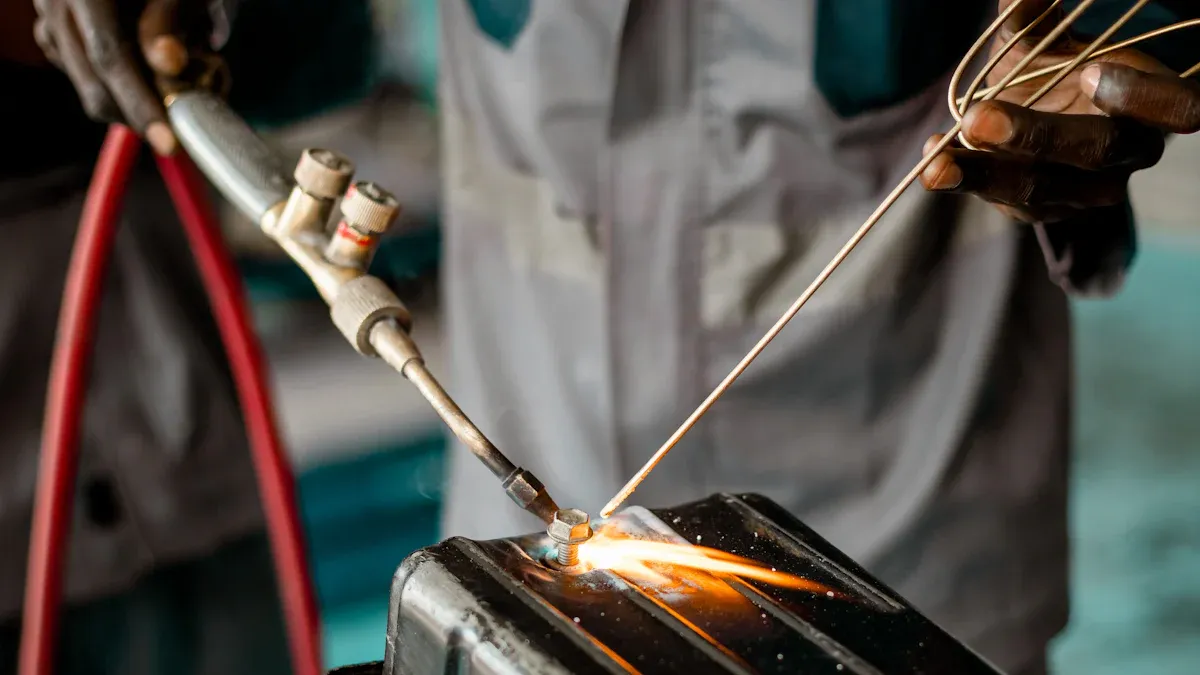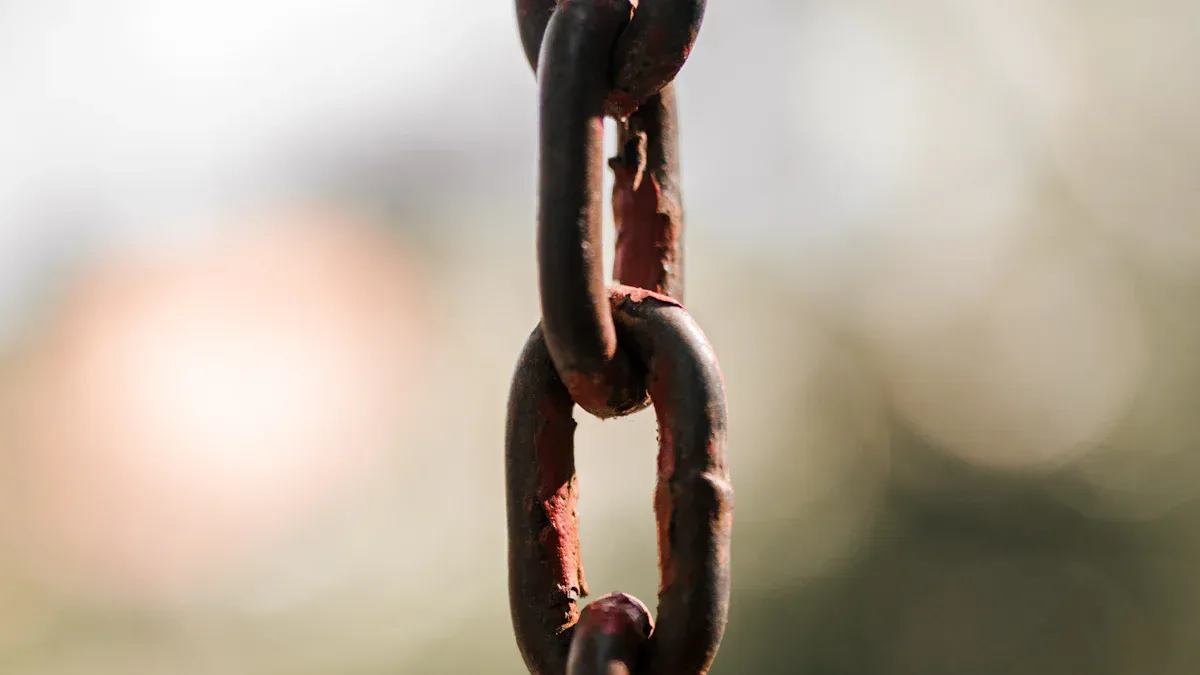How strong is a welded chain?

Welded chains are made to be strong and dependable. They are used in jobs where strength is very important, like building and shipping. These chains can hold heavy weights: Hi-Test steel chains can carry up to 9,200 pounds, and proof coil chains can hold up to 4,500 pounds. New ways of making them, like using AI and lasers, make them even better. These improvements help welded chains stay very safe to use.
Principales conclusiones
- Welded chains are very strong and can lift heavy weights. Hi-Test steel chains can hold up to 9,200 pounds.
- Picking the right chain grade is very important. For heavy lifting, use Grade 80 or higher to stay safe and follow rules.
- Taking care of chains, like cleaning and oiling them, stops rust. This also makes welded chains last longer, especially in tough conditions.
Understanding welded chains

What is a welded chain?
A welded chain has links joined by welding. This makes the links strong and hard to break. These chains can carry heavy weights and last a long time. Most welded chains are made of steel, which adds to their strength. They are built to follow rules like those in ASME B29.200. This rulebook gives clear instructions for making mill and drag chains.
| Standard Code | Descripción |
|---|---|
| B29.200 | Explains how to make mill and drag chains. |
| B29.16M | Lists sizes and parts for mill chains. |
| B29.18M | Focuses on drag chains for tough jobs. |
Common applications of welded chains
Welded chains are used in many industries because they are strong. In construction, they lift and hold heavy items. Shipping companies use them to secure cargo during trips. Factories use these chains in machines to move products. Their strength and safety make them useful in many places.
Types of welded chains
There are different types of welded chains for various jobs. Some examples are:
- Engineering Drive Chain: Used in engineering tasks.
- Engineering Conveyor Chain: Perfect for conveyor belts.
- Welded Steel Mill and Drag Chain: Made for tough mill work.
- Rooftop Chain: Works well for rooftop tasks.
- Drop Forged Rivetless Chain: Common in factories.
- Cast Chain: Handles very heavy loads.
- 81X Heavy Chain: Built for hard jobs.
- 81X Heavy/Heavy Chain: Extra strong for big loads.
- 81X Conveyor Chain Attachments: Improves conveyor chain use.
Welded chains are also grouped by grades. For example:
- Proof Coil Chain (Grade 30): Good for light work.
- High Test Chain (Grade 40): Strong for heavy trucking.
- High Test Boomer Chains: Meets ASTM rules for lifting heavy things.
Each type of chain is made for a specific job, so you can pick the right one for your needs.
Factors affecting the strength of welded chains
Material composition and grades
The material of a welded chain affects its strength. Chains made from strong steel last longer and carry more weight. But welding can change the steel’s structure in the heat-affected zone (HAZ). This area may weaken because of the welding heat. Studies show welding can either weaken or strengthen steel, depending on the method. For example:
| Condition | Absorbed Energy (J) | Toughness (J/mm²) |
|---|---|---|
| Without Hardening | 126.33 | 1.57 |
| With Hardening | 170.65 | 2.12 |
The table shows how hardening after welding makes steel tougher. Picking the right steel grade helps the chain handle stress better.
Welding quality and manufacturing process
Good welding is key to a strong chain. Bad welding creates weak spots that can break under heavy loads. Advanced methods like robotic welding ensure better quality. These techniques reduce mistakes and make chains stronger. Always check if the chain meets safety rules before using it.
Chain design and link size
The chain’s design and link size decide how much weight it holds. Bigger links spread weight evenly, lowering stress on parts. Thicker links are best for heavy jobs. Always choose a chain design that fits the task to avoid overloading.
Environmental conditions and durability
Weather and surroundings can weaken chains over time. Moisture, heat, or chemicals can cause damage. Chains used near water need to resist rust. Galvanized or stainless steel chains work better in such places. Cleaning and oiling chains often can make them last longer.
Consejo: Keep chains dry to stop rust. Check them often for damage.
Load capacities of welded chains

Maximum working load capacities of welded chains
The strength of a welded chain depends on its grade and material. Chains are grouped by grades based on their strength and uses. For example, Grade 30 chains are made of carbon steel. They are good for light jobs but not for lifting overhead. Grade 80 and higher chains are made of alloy steel. These are strong enough for heavy lifting, including overhead tasks. These grades follow strict rules from groups like OSHA and ASME.
| Chain Grade | Tipo de material | Recommended Use | Load Capacity Standards |
|---|---|---|---|
| 30 | Carbon Steel | Not for overhead lifting | OSHA, ASME |
| 43 | Carbon Steel | Not for overhead lifting | OSHA, ASME |
| 70 | Carbon Steel | Not for overhead lifting | OSHA, ASME |
| 80 | Acero aleado | Recommended for overhead lifting | OSHA, ASME |
| 100 | Acero aleado | Recommended for overhead lifting | OSHA, ASME |
| 120 | Acero aleado | Recommended for overhead lifting | OSHA, ASME |
Always check the chain’s grade to match it with the job.
Examples of load ratings for different chain types
Different welded chains have different load limits. For example, Grade 30 proof coil chains can carry lighter loads. Grade 80 alloy chains are made for heavy lifting. Grade 100 chains are even stronger and used in industries. Always check the maker’s guide for the chain’s exact load limit. Using a chain beyond its limit can cause accidents or breakage.
Safety guidelines for using welded chains
Follow safety rules when using welded chains. Never overload the chain and check it often for damage. Chains used for lifting must meet OSHA and ASME rules. Also, think about the forces on the chain during use. For example, forward deceleration should stay below 0.8 g. Sideways acceleration should not go over 0.5 g.

Consejo: Keep chains dry and oil them to stop rust. Good care makes them last longer and stay safe to use.
Welded chains are known for being strong and reliable. Their materials and design make each link equally strong. This helps them carry heavy loads without breaking. Welding makes the chains last longer and stay tough. Bigger links can hold more weight safely. These qualities make welded chains perfect for hard and important jobs.
PREGUNTAS FRECUENTES
Why are welded chains stronger than other chains?
Welded chains have links joined tightly together. This makes them one solid piece. The design spreads weight evenly and avoids weak spots. This is why they are stronger than chains without welding.
Can welded chains be used in wet or harsh environments?
Yes, they can. Use galvanized or stainless steel chains for these places. These materials stop rust and damage, keeping the chains strong.
Consejo: Check and clean chains often in wet areas. This helps them last longer.
How do you pick the right chain grade for your job?
Look at the chain’s grade and match it to your task. For heavy loads, choose Grade 80 or higher. Always follow the maker’s instructions.




Venture into the epic sandbox of EVE Online. Become a legend today. Conquer alongside millions of pilots worldwide. Begin your journey
Thanks for sharing. I read many of your blog posts, cool, your blog is very good.